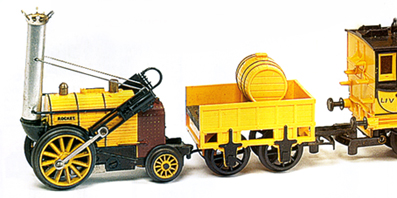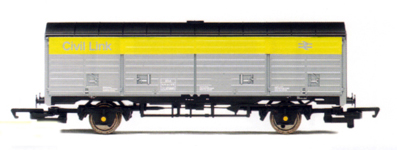Article
Favourite Models – Tri-ang’s Rocket
Author: Evan Green-Hughes
Date: 14 March 2011
Related Model: Stephensons Rocket Train Pack
This article originally featured in the June 2010 edition of the Hornby Magazine.
Almost everyone has heard of Stephenson’s Rocket. However, despite Rocket’s celebrity status, there has only been one attempt by a major manufacturer to produce a working model in ‘OO’ - and that came 47 years ago as Evan Green-Hughes explains.
Built by George Stephenson in 1829 Rocket introduced many of the principles of modern steam locomotive construction, including multi-tubed boilers and inclined cylinders. It won the famous Rainhill Trials and proved once and for all that steam traction was a serious possibility for long distance travel at high speeds, Withdrawn and sold for use on a colliery line as long ago as 1836 the locomotive was preserved a staggering 148 years ago, its lightweight small design no match for the increases in speed and pulling power demanded by the Victorian railway system.
A century later, the decision by Triang Railways to produce a working model was probably as sensational to the 1960s railway modeller as the actual machine had been to travellers in 1829. In those far-off days electric motors were much larger than today and we were all used to seeing the cabs of fairly large model steam locomotives filled with Ringfield motors and the like. Pick ups were fairly rudimentary too, and if you wanted to own a model which would perform well over points then you usually made sure that it had plenty of wheels.
Triang was convinced these problems could be overcome and that production of the model would be worthwhile - but the project proved to be something of a trial. The biggest issue was the small space available for the motor which resulted in the company designing the tiny X500, which was later to be used with much success on the Minic Motorways range. Almost as problematical was the adhesion weight - the model was so light that it would potentially be unable to move or pull anything. Traction tyres could not be used because all the available wheels were required for picking up current from the track and it was impossible to get any more weight into the locomotive. The answer was the employment of the Magnadhesion principle, which involved using magnets to assist in pulling the locomotive towards the steel rails and which was fairly common on Triang models at the time.
As conventional body/chassis structures were also not possible the body was specially designed so it was held together by the chimney stays, which clasped the chimney and kept everything in place. The designers even found a place for a smoke unit - quite an achievement in a locomotive only 55mm long!
The resulting model was delightful and it made its debut in autumn 1963 as R651S and there was a matching tender, with the catalogue number R652. Also available were matching coaches, which came with the names Times, Experience and Despatch, but which all seem to have been issued under the catalogue- number of R621 when sold individually. Some early versions of these are reported as having the wording ‘Railway Company’ at the bottom of the centre coach doors.
Launched on the cover of the 1963 catalogue the model proved very popular although it was notorious for its eccentric running properties. While the original Rocket was good for around 25mph the model would scarcely run below that speed and was a good match for an ‘A4’ with the controller anything above half power! Some locomotives ran very badly and others had a distinct wobble from side to side and as a result many were not run much, which has probably resulted in rather more than usual surviving in their original boxes.
Rocket was produced until 1968 and sold particularly well abroad with at least 37,000 being made, including over 500 which were assembled and sold in Australia. The most popular version was the R346 presentation set which consisted of Rocket, its tender and one coach, and which accounted for almost 95% of the sales. During the period of production there were a few detail differences: the smoke unit was dropped in 1966 and the catalogue number changed to R651. The chimney stays, which had proved susceptible to damage, were permanently attached in later models.
Although Rocket and its coaches were dropped from the range in 1968 the coaches were again released in the mid 1970s, although this is thought to have been to clear out old stock. ln January 1983, however, there was a proper re-issue and set R796 appeared which this time had the locomotive, tender and three coaches. Again there were small changes to the specification, with metal wheels and a revised coupling provided. Around 5,000 were made and these continued to be available until around 1988. There was an altemative number for this set, which was R771, and which may well have been for export.
As well as the Australian variant in the 1960s Rocket was also made and packaged for France where it was sold by Hornby Acho and also for ATF for sale in the USA.
Despite Rocket being such a appealing model it has never been worth huge sums of money to the collector. As mentioned above many more than usual have survived in their original packaging with prices tending to depend more on the condition of the locomotive and packaging rather than on which period it has come from.
Foreign versions are worth much more, particularly the American releases, but you can buy a good quality locomotive for around 40 pounds. Most of those to be found at auction are naturally within the R346 set, which includes a coach. You’d need to have about 100-110 pounds to buy one of these if it had its original box in good condition, but these have changed hands for as little as 40 pounds when unboxed, worn or damaged. An absolutely mint one with all the original packaging and instructions fetched 150 pounds at a recent Vectis Auction.
Even though around 50,000 of these little locomotives have been made I have yet to see a layout based round one of them. Surely a section of the LiverpooI-Manchester circa 1830 would make an interesting model for someone to tackle? Even if the Triang model does have its shortcomings it would certainly make for an interesting and inexpensive start to what would be an unusual project.
For more information about Vectis Auctions model railway sales call 01642 750616 or visit www.vectis.co.uk where full details of past and coming auctions can be found.
Triang Railways introduced its ‘OO’ gauge model of Stephenson’s Rocket in 1963. This collection of vehicles includes the locomotive, tender, two Despatch coaches and one Times coach all of which could be obtained as separate items.
Evan Green-Hughes
Photography: Vectis Auctions



















